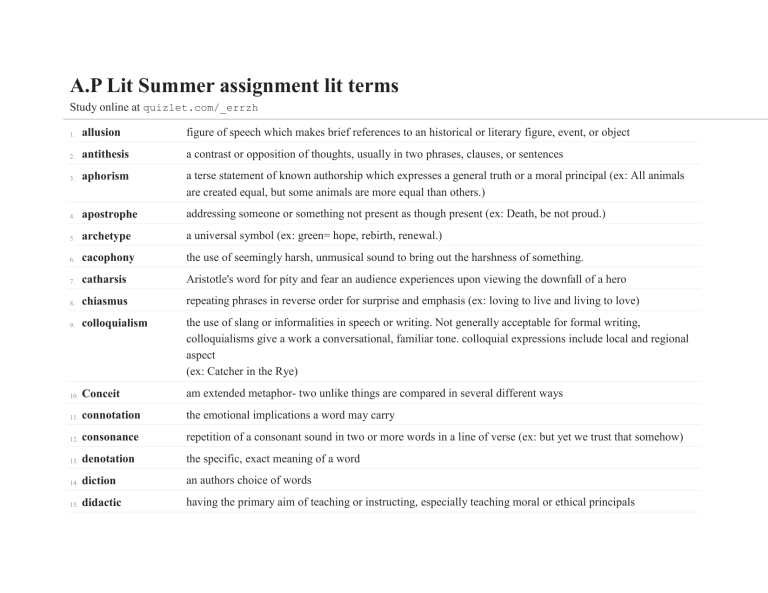
A.P Lit Summer assignment lit terms Study online at quizlet.com/_errzh 1. allusion figure of speech which makes brief references to an historical or literary figure, event, or object 2. antithesis a contrast or opposition of thoughts, usually in two phrases, clauses, or sentences 3. aphorism a terse statement of known authorship which expresses a general truth or a moral principal (ex: All animals are created equal, but some animals are more equal than others.) 4. apostrophe addressing someone or something not present as though present (ex: Death, be not proud.) 5. archetype a universal symbol (ex: green= hope, rebirth, renewal.) 6. cacophony the use of seemingly harsh, unmusical sound to bring out the harshness of something. 7. catharsis Aristotle's word for pity and fear an audience experiences upon viewing the downfall of a hero 8. chiasmus repeating phrases in reverse order for surprise and emphasis (ex: loving to live and living to love) 9. colloquialism the use of slang or informalities in speech or writing. Not generally acceptable for formal writing, colloquialisms give a work a conversational, familiar tone. colloquial expressions include local and regional aspect (ex: Catcher in the Rye) 10. Conceit am extended metaphor- two unlike things are compared in several different ways 11. connotation the emotional implications a word may carry 12. consonance repetition of a consonant sound in two or more words in a line of verse (ex: but yet we trust that somehow) 13. denotation the specific, exact meaning of a word 14. diction an authors choice of words 15. didactic having the primary aim of teaching or instructing, especially teaching moral or ethical principals 16. 17. 18. 19. dramatic irony when the audience or reader knows something that the character does not so that what he says is ironic (Ex: Oedipus saying that he wants to catch who caused the plague when we all know that it was he who caused the plague) dynamic character a character who changes dramatically over the course of a work euphony a quality or style marked by pleasing sounds extended metaphor a metaphor developed at a great length, occuring frequently in or throughout a work extended parallelism the repetition of words of grammatical elements to achieve cumulative force and rhythm (Ex: the bear went over the mountain, the bear went over the mountain, the bear went over the mountain, to see what he could see) figurative language writing or speech not meant to be taken literally 22. foil character who provides a contrast to another character, thus emphasizing the other's traits 23. hubris the pride or overconfidence which often leads a hero to overlook divine warning or to break a moral law 24. imagery devices which appeal to the senses: visual, tactile, auditory, olfactory, kinetic 25. irony contrast between reality and expectation (ex: a fire house burning down) 26. juxtaposition a poetic and rhetorical device in which normally unassociated ideas, words, or phrases are places next to one another, creating an effect of surprise and wit. 27. litotes understatement employed for the purpose of enhancing the effect of the ideas expressed. contains a negative (ex: that was no small task!) 28. mask(persona) a character with a distinct identity created by an author to achieve a particular effect of or to deliver a particular message which reflects the author's point of view 20. 21. metonymy or metonomy substituting a word naming an object for another word closely associated with it (ex: pay tribute to the crown, crown symbolizing of the king and queen) 30. mood the atmosphere of a literary work or the feelings that are elicited in the reader by the author 31. motif a main theme or subject 32. oxymoron technique used to produce an effect by a seeming self-contradiction (ex: cruel kindness) 33. paradox a statement or concept that seems contradictory, unbelievable, or absurd but that may actually be true in fact (ex: war brings peace) 34. parallelism refers to the repeated use of phrases, clauses, or sentences that are similar in structure and meaning. writers use this technique to emphasize important ides, create rhythm, and make their writing forceful and direct 35. pedantic teaching: instuctive (a pedantic tone is usually stuffy and formal) 36. point of view the perspective in which a story is told ( 1 person - I, 2 person- you, 3rd person - he/she- omniscient narrator 37. rhetorical question a question that expects no answer. it is used to draw attention to a point and is generally stronger than a direct statement. 38. shift a change of feelings by the speaker from the beginning to the end, paying particular attention to the conclusion of the literature 39. situational irony irony that arises from situations as opposed to verbal irony 40. static character a character that remains unchanged by the conclusion of a work stream fo consciousness narrative technique that presents thoughts as if they were coming directly form the character's mind (ex: Catcher in the Rye) 42. symbol anything that stands for or represents something else 43. synecdoche figurative language in which the part stands for the whole (ex: nice wheels, in commenting the car) 44. syntax the arrangement of words in a sentence 29. 41. 45. tone a writers's attitude toward his subject 46. tragic flaw a tragic flaw or error in judgement (ex: oedipus's tragic flaw was his hubris) 47. understatement statement in which literal sense of what is said falls short of the magnitude of what is being talked about 48. verbal irony a kind of irony in which words are used to suggest the opposite of their actual meaning 49. vernacular using the native language of a country or place; commonly spoken by the people of a particular country or place ( ex: Huck Finn was written in the vernacular of the south) 50. voice the "speaker" in a piece of literature





